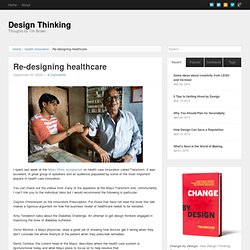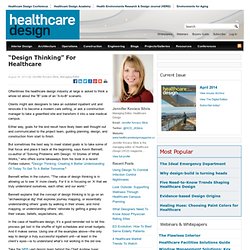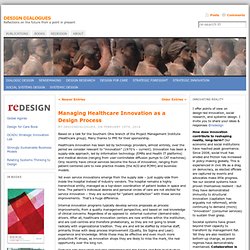

Re-designing healthcare. I spent last week at the Mayo Clinic symposium on health care innovation called Transform.

It was excellent. A great group of speakers and an audience populated by some of the most important players in health care innovation. You can check out the videos from many of the speakers at the Mayo Transform site. Unfortunately I can’t link you to the individual talks but I would recommend the following in particular: Clayton Christensen on the Innovators Prescription. Amy Tenderich talks about the Diabetes Challenge. Victor Montori, a Mayo physician, does a great job of showing how doctors get it wrong when they don’t consider the whole lifestyle of the patient when they prescribe remedies. Denis Cortese, the current head of the Mayo, describes where the health care system is dysfunctional today and what Mayo plans to focus on to help resolve that.
Elizabeth Teisberg talks about health care policy and in particular the importance of focusing on value not cost reduction. Design Thinking in Health Care. “Design Thinking” For Healthcare. Oftentimes the healthcare design industry at large is asked to think a whole lot about the “B” side of an “A-to-B” scenario.

Clients might ask designers to take an outdated inpatient unit and renovate it to become a modern care setting, or ask a construction manager to take a greenfield site and transform it into a new medical campus. Either way, goals for the end result have likely been well thought out and communicated to the project team, guiding planning, design, and construction from start to finish. But sometimes the best way to meet stated goals is to take some of that focus and place it back at the beginning, says Kevin Bennett, co-author of “Solving Problems with Design: 10 Stories of What Works," who offers some takeaways from his book in a recent Forbes column, "Design Thinking: Creating A Better Understanding Of Today To Get To A Better Tomorrow. " Bennett writes in the column, "The value of design thinking is in allowing us to see ‘A’ more clearly.
Managing Healthcare Innovation as a Design Process. Design Dialogues. So we might ask, is there a definable field and practice of systemic design?

With Jeremy Bowes, we teach a course in system titled Systemic Design in the Strategic Foresight and Innovation program at OCADU. We believe systems thinking to be one of the core “thinkings” for the SFI program (design, business, and futures thinking, “surrounded” by creative systems thinking). Over the 5 years of teaching the program and producing futures and strategic design studies for agencies and clients, we have found systemic design becoming one of the most differentiating and persuasive competencies, both in its underpinning theory and social technologies.
We’ve been making the invisible college of this practice a lot more visible. Working with Birger Sevaldson at AHO, Oslo for the last few years, we’ve coordinated curriculum and methods and have exchanged workshops to develop systems thinking methods in strategic design and service design. There’s too much value at stake to fuss around. The Healthcare Innovator’s Challenge. Adapted from Design for Care (page 253 ) The innovator’s challenge in healthcare is not a technological fix – it is more to understand and preserve core values of human care while changing practices for durable social and economic benefit.

Although economic value is often a pivotal driver of innovation adoption, cost management is not itself a core value but a sustainability factor to be evaluated in decision making. The related social innovation challenge is a macro policy problem, not a design issue. An immediate challenge is convincing organizations that accessible patient-centred, value-based care is actually possible with a business model change. (Then new care service models can be designed). Using a simple Business Model Canvas model, a shared value healthcare business model (based on Porter & Lee’s value-based care) is outlined.
Such a shift may seem impossible in today’s lean, cost-contained, time-sliced organizations. *Murray, C. Design Thinking In Healthcare: One Step At A Time. Why Health Care Needs Creative Thinking More Than Ever. Joel Dudley, one of Fast Company’s Most Creative People of 2014, is director of biomedical informatics for Icahn School of Medicine at Mount Sinai Medical Center in New York City and co-author of the book, Exploring Personal Genomics.

His research focuses at the nexus of biology, medicine and big data to advance “precision medicine”--the tailoring of health care to each individual’s unique molecular composition to better treat and prevent disease. Co.Exist editor Jessica Leber spoke to him about how creativity with data has the potential to change the field of health as we know it. What does it mean to you to be creative in health care? Creativity in health care versus other fields is not in its essence different. It’s just creativity. Another aspect of creativity is bringing in perspectives from other areas and applying it in medicine. How can more creativity improve health care? Creativity can help break down the artificial barriers that we have in medicine.
We’re at an exciting time.